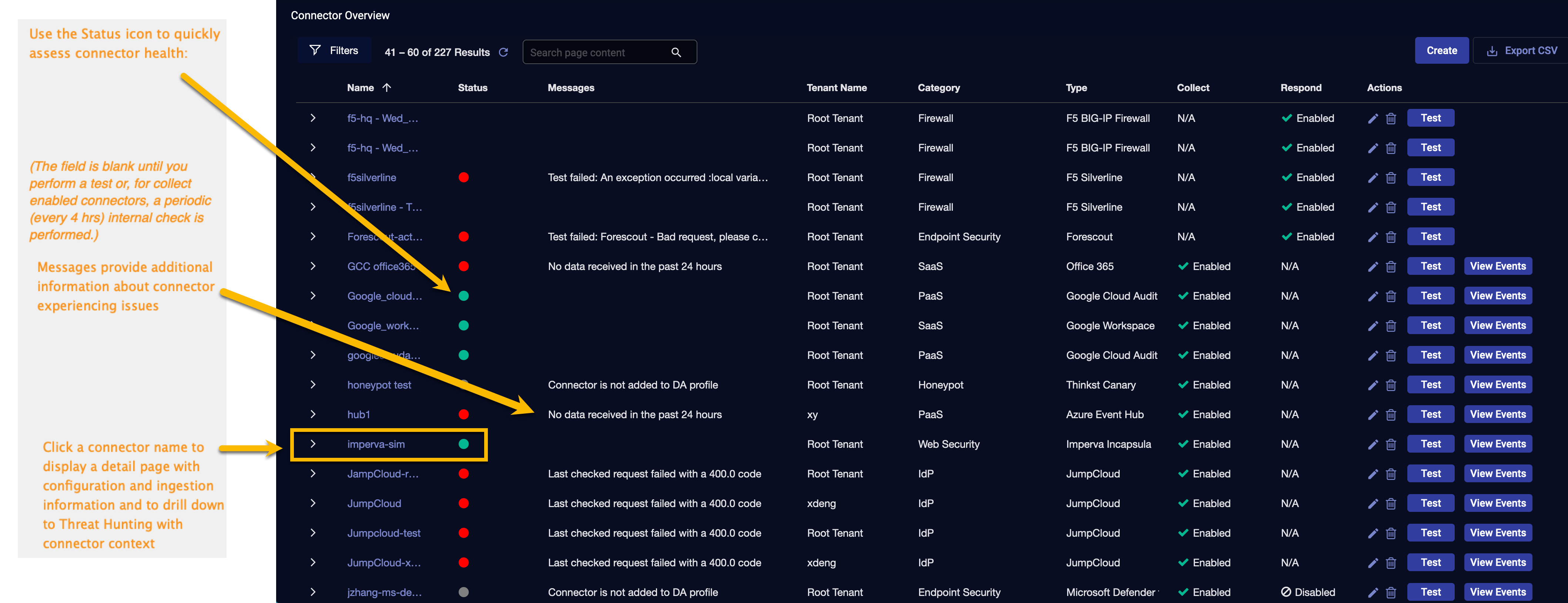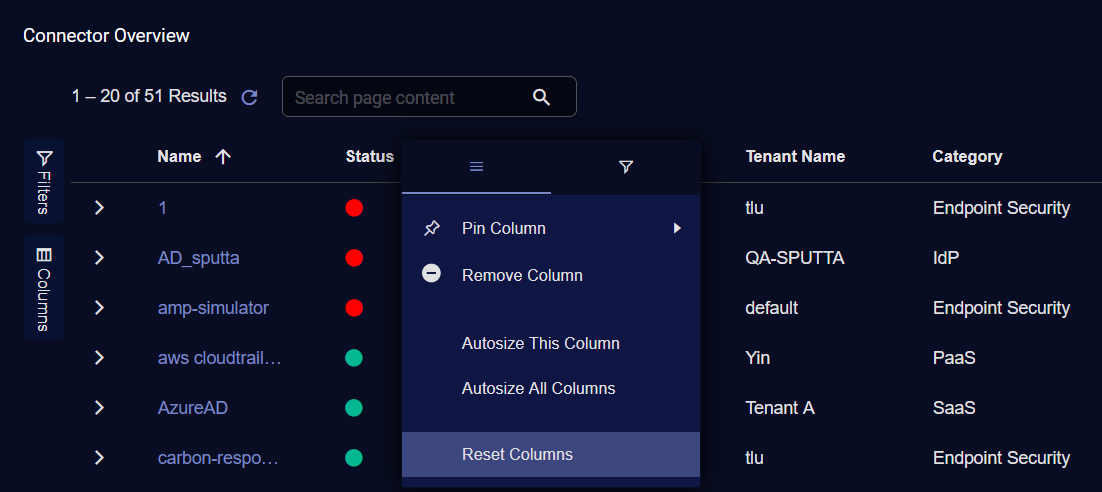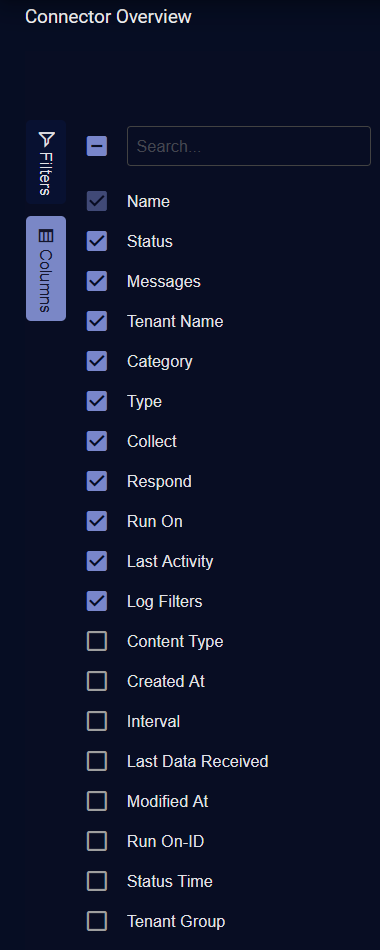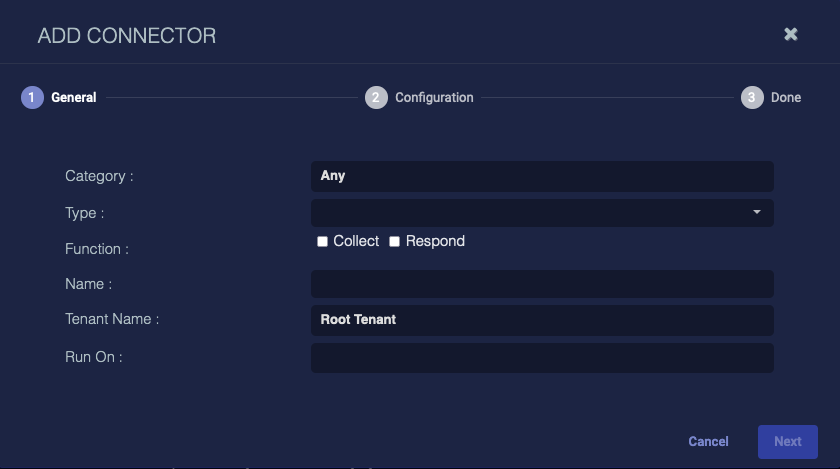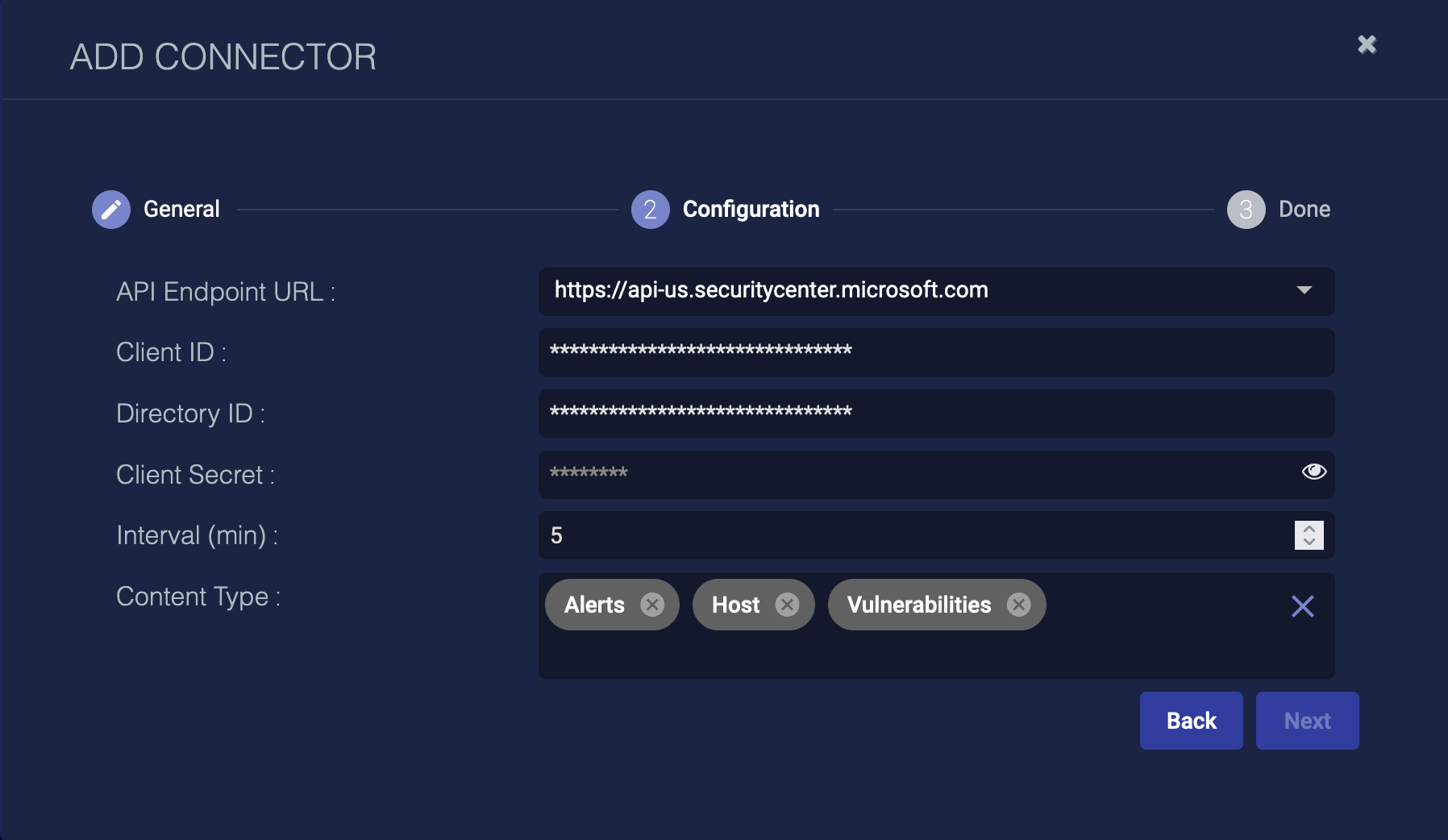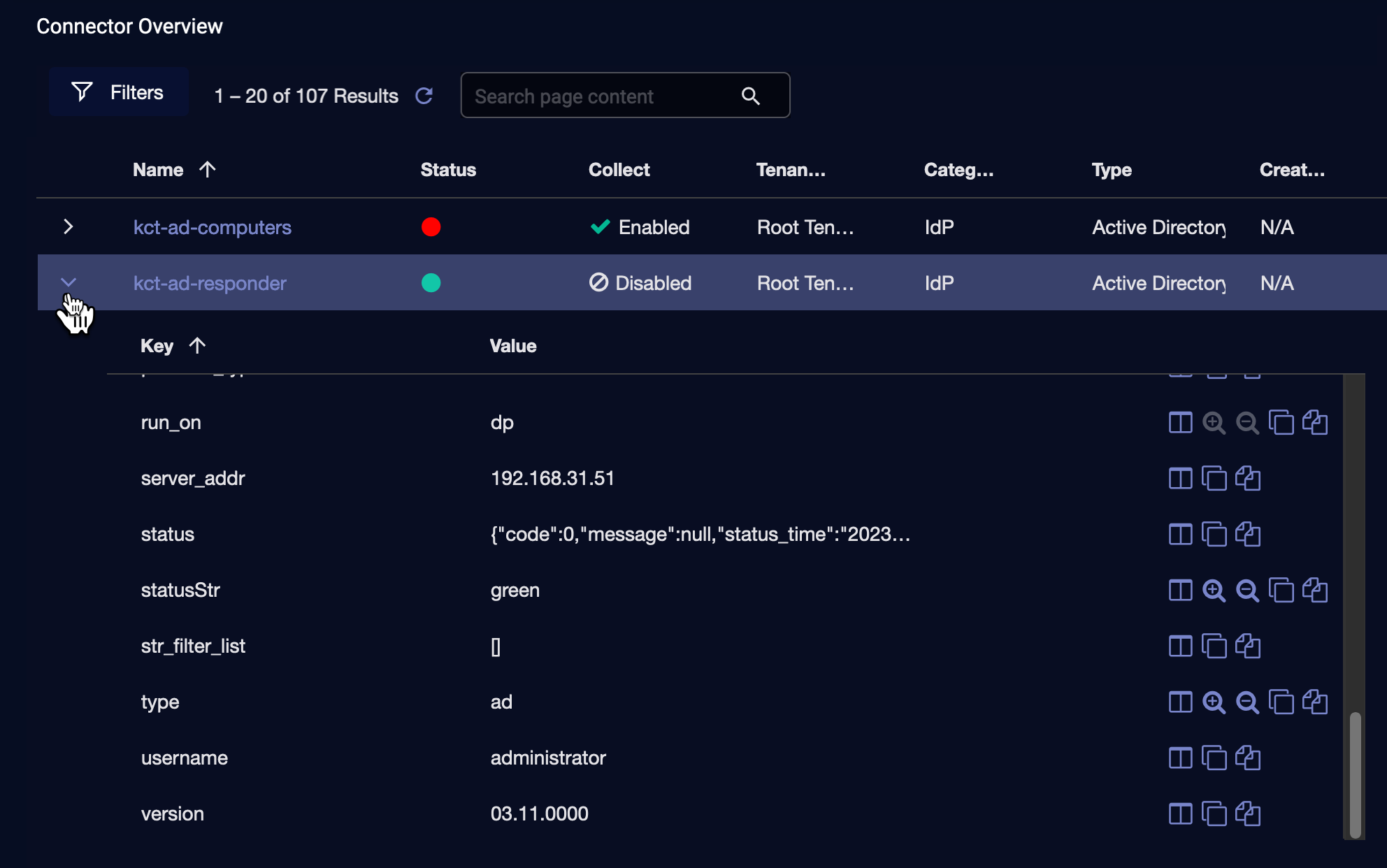Working with the Connectors Table
Stellar Cyber can connect to other resources in your network. This allows you to collect information from your IdP, endpoint security, vulnerability scanners, and other systems, as well as to push actions to your firewalls. The connectors table lists all connectors that have been configured.
The table behaves like all other Stellar Cyber tables. You can change the displayed columns, sort by columns, and export the displayed list, for example. This table also includes a Last Activity column, which is the timestamp for the last successful activity for that connector. ![]()
There are several columns in the Connectors table. To see the default columns, click the icon (![]() ) in the table header and select Reset Columns.
) in the table header and select Reset Columns.
To see all the columns that you can display in the table, click Columns. You can add or remove columns in the table using check boxes.
Some of the columns are as follows:
-
Name—the name of the connector
-
Category—the connector category, for example, IdP, Endpoint Security, or Firewall
-
Content Type—the content type of the logs, for example, Alerts or Events
-
Interval—the configured interval, for example, 5 minutes
-
Run On—the device on which the connector runs, for example, Data Processor
-
Status—the status of the connector. See Connector Status in Connector Table for details.
Use the following as a guide to understand the connector-specific operations you can perform in this table:
-
Collect column:
-
Active / Inactive toggle: When you enable the collect function of a connector during configuration, the collect function is deployed in an active (running) state on the Data Processor or the specified sensor. Use the toggle to switch the connector between Active and Inactive states without deleting it.
-
Disabled status: This indicates that the connector supports the Collect function but the feature is not enabled. You can edit the connector to activate the function.
-
N/A: Collect is not supported for this connector type.
-
-
Respond column:
-
Enabled status: This means that the function is supported and selected for that connector. Responders operate in a reactive manner, so the option to toggle to inactive is not offered for this function.
-
Disabled status: This indicates that the connector supports the Respond function but the feature is not enabled. You can edit the connector to activate the function.
-
N/A: Respond is not supported for this connector type.
-
-
View Events button:
This button is displayed for applicable connectors and allows you to jump to an Investigate | Threat Hunting view that is filtered on the selected connector. This feature is not applicable for respond-only connector types such as Firewalls or Remote SSH.
For a list of connectors and their supported functions, refer to: Connector Types & Functions.
Use this topic to understand how to:
- Add a new connector
- Edit an existing connector
- Test a connector
- Delete a connector
- Analyze connector details / statistics
- View full connector details
For guidance ingesting log data, refer to Ingesting Logs.
Connector Status in Connector Table
The connector status is displayed in the Connector table in the Status column. There are different colors for different statuses in the user interface. In addition, a message displays when you hover over the Status, for example: No data received in the past 24 hours.
| Category | Status Priority | Color | Number |
Message |
Description |
|---|---|---|---|---|---|
| Status not available | 1 | Clear |
-1 |
Status not available |
Connector status is not supported for this connector. |
| Status not available | 1 | Clear | -1 |
Status not available, please upgrade the sensor |
The sensor the connector runs on must be upgraded to the latest version to support connector status. |
| Connector is inactive | 2 | Grey | 1 |
Connector is not added to DA profile |
Connector is not added to a Data Analyzer (DA) profile. |
| Last activity failed | 3 | Red | 2 |
{{Fail reason}}” or “Last checked request failed with a {{http or status}} code |
Request from connector failed. If a properly formatted error message was returned that will be displayed, else only the code. |
| Test failed | 3 | Red | 4 |
Test failed: {{}} |
Test failed, and the reason will be displayed if there was a properly formatted error message. |
| No data in the past 24 hours | 4 | Amber | 3 |
No data received in the past 24 hours |
The connector is active ( |
| Healthy | - | Green | 0 |
Nil |
None of the listed issues. |
Notes:
-
Color is shown in the UI. The connector record from the connector API will have
status.codefor Number, andstatus.messagefor Message. Automatic connector status is only available for Collect-enabled sensors. Respond-only connectors will get their status only through connector tests. -
Status Priority is the order of status overwriting the rest. Test failed will overwrite Last activity failed when a test is performed, but if there is failed activity in the automatic checks, Last activity failed will overwrite to show what could be the latest error as the time window for checking failed activity is 15 minutes ago to present time.
Successfully receiving data will clear Last activity failed, Test failed, and No data in the past 24 hours if status is available for the connector and the connector is active. Status is updated every 5 minutes unless a test is performed.
-
Invalid credentials or configurations may not generate requests that will trigger Last activity failed. Unless you run a test, this status may remain as No data received in the past 24 hours.
Adding and Editing Connectors
Adding and editing provide the same configuration options; the only difference is that you can't edit the General configuration options. Click Create to create a new connector or ![]() to edit an existing connector. After you have obtained the credentials for your external service and configured API or other access for Stellar Cyber community, there are three basic steps to configuring a connector in Stellar Cyber.
to edit an existing connector. After you have obtained the credentials for your external service and configured API or other access for Stellar Cyber community, there are three basic steps to configuring a connector in Stellar Cyber.
For detailed steps on obtaining credentials, configuring, and testing specific connectors, select your connector from the Connector Types & Functions.
For a quick overview, click through the slides below:
Testing a Connector
When you add (or edit) a connector, we recommend that you run a test to validate the connectivity parameters you entered. (The test validates only the authentication / connectivity; it does not validate data flow).
-
Click System | Integrations | Connectors. The Connector Overview appears.
-
Locate the connector that you added, or modified, or that you want to test.
-
Click Test at the right side of that row. The test runs immediately.
Note that you may run only one test at a time.
Stellar Cyber conducts a basic connectivity test for the connector and reports a success or failure result. A successful test indicates that you entered all of the connector information correctly.
To aid troubleshooting your connector, the dialog remains open until you explicitly close it by using the X button. If the test fails, you can select the button from the same row to review and correct issues.
The connector status is updated every five (5) minutes. A successful test clears the connector status, but if issues persist, the status reverts to failed after a minute.
Repeat the test as needed.
If the test fails, the common HTTP status error codes are as follows:
| HTTP Error Code | HTTP Standard Error Name | Explanation | Recommendation |
|---|---|---|---|
| 400 | Bad Request | This error occurs when there is an error in the connector configuration. |
Did you configure the connector correctly? |
| 401 | Unauthorized |
This error occurs when an authentication credential is invalid or when a user does not have sufficient privileges to access a specific API. |
Did you enter your credentials correctly? Are your credentials expired? Are your credentials entitled or licensed for that specific resource? |
| 403 | Forbidden | This error occurs when the permission or scope is not correct in a valid credential. |
Did you enter your credentials correctly? Do you have the required role or permissions for that credential? |
| 404 | Not Found | This error occurs when a URL path does not resolve to an entity. | Did you enter your API URL correctly? |
| 429 | Too Many Requests |
This error occurs when the API server receives too much traffic or if a user’s license or entitlement quota is exceeded. |
The server or user license/quota will eventually recover. The connector will periodically retry the query. If this occurs unexpectedly or too often, work with your API provider to investigate the server limits, user licensing, or quotas. |
For a full list of codes, refer to HTTP response status codes.
Deleting a Connector
To delete a connector you must first remove it from the data analyzer profile (firewall and vulnerability scanner connectors are not included in data analyzer profiles, so can skip these steps):
-
Click System | Data Processor | Data Analyzer Profile.
-
Click the
 button next to the profile containing the connector. The EDIT DATA ANALYZER PROFILE screen appears.
button next to the profile containing the connector. The EDIT DATA ANALYZER PROFILE screen appears. -
Find the connector in the Added field under Optional Data Source.
-
Click next to the connector. The connector is immediately removed.
-
Click Submit. The profile is saved, and the connector is no longer in use.
When the connector is removed from all data analyzer profiles, you can delete it:
-
Click System | Integration | Connectors.
-
Click next to the connector you want to delete. A confirmation dialog box appears.
-
Click OK. The connector and configuration information are immediately deleted.
If you see a warning that Data source is in use, cannot be deleted, the connector is still in a data analyzer profile. Remove it from all profiles.
Analyzing Connector Details
Connectors send statistics to the DP, quantifying the data being sent and its source once per minute. This data is stored in the Sensor Monitoring (aella-ade) index on the DP. You can analyze this data using the Threat Monitoring interface (see procedure below). ![]() , from which you can also jump to the Threat Monitoring interface, with context. Access Connector Details by clicking the name of the connector from the connector list.
, from which you can also jump to the Threat Monitoring interface, with context. Access Connector Details by clicking the name of the connector from the connector list.
-
Log in to Stellar Cyber.
-
Navigate to Investigate | Threat Hunting.
-
Click the Indices dropdown and make sure that the Sensor Monitoring index is selected.
-
Scroll down to the Document table, enter msgtype:40 in the Search field, and press Enter to filter on just this msgtype. This is the msgtype that quantifies ingestion by connector.
-
The table updates to show all entries passing the global filters at the top of the display for Message Type 40. You can add the Connector Name column to see where the data came from.
The other key fields to look for are as follows:
-
engid_name—the name of the connector
-
http_code—the return code from the API
-
in_bytes_delta—the size of the events pulled
-
in_records_delta—the number of events sent to the DP
-
out_bytes_delta—the size of the messages pulled
-
out_records_delta—the number of events sent to the DP
-
Viewing Full Connector Details
Click the down arrow on the Connector Overview page to view full details for a connector.
Some of the fields are as follows:
Fields do not display if they are None or if they do not apply.
-
category—the connector category, for example, idp, email, firewall
-
content_type—the content type of the logs, for example, ["events"] or ["threats"]

-
interval—the configured interval
-
log_type—the type of log, for example, ad (Active Directory) or proofpoint_tap
-
run_on—the device on which the connector runs, for example, dp (Data Processor)
-
status—the information about the status:
{"code":3,"message":"No data received in the past 24 hours","status_time":"2023-11-02 11:24:26"}
-
code—the status code from 0 to 4 as follows:
CONNECTOR_HEALTHY_CODE = 0
CONNECTOR_NOT_ADDED_TO_DA_CODE = 1
CONNECTOR_ACTIVITY_FAIL_CODE = 2
CONNECTOR_NO_DATA_CODE = 3
CONNECTOR_TEST_FAIL_CODE = 4
-
message—the status message associated with the code
-
status_time—the status timestamp
-
